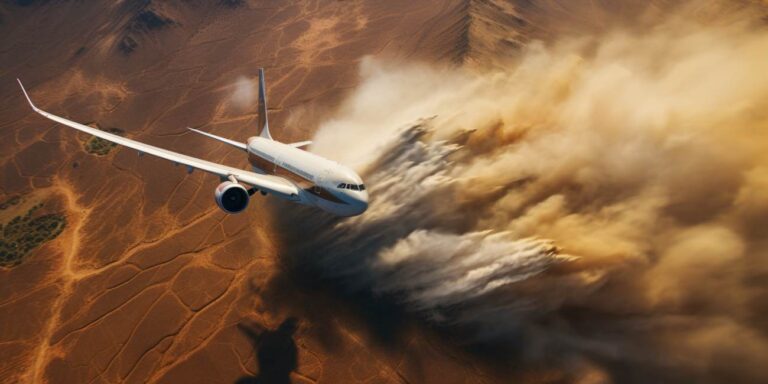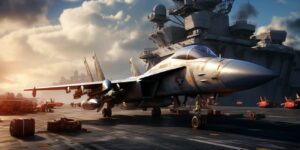Lift is the force that enables an aircraft to defy gravity and soar through the skies. It is generated by the wings as air flows over and under them. The shape of the wing, often referred to as the airfoil, plays a crucial role in creating this upward force. The Bernoulli’s principle comes into play here, where the pressure on the top of the wing is lower than the pressure on the bottom, resulting in lift.
Weight, the gravitational force acting on the aircraft, pulls it towards the Earth. It acts vertically downward from the aircraft’s center of gravity. Achieving a state of equilibrium between lift and weight is crucial for level flight. Pilots manipulate control surfaces, like ailerons and elevators, to maintain this balance during various phases of flight.
Complementing lift and weight, thrust and drag complete the quartet of forces governing an aircraft’s motion. Thrust is the forward force provided by the aircraft’s engines. It opposes drag and propels the aircraft through the air. Pilots adjust thrust to control speed and achieve desired flight paths. Jet engines, propellers, and even rocket engines contribute to generating this crucial force.
Drag, the aerodynamic resistance encountered as an aircraft moves through the air, acts opposite to thrust. It results from friction and turbulence. Pilots strive to minimize drag for optimal fuel efficiency and speed. Streamlining the aircraft’s shape, retracting landing gear, and using advanced materials are among the strategies employed to reduce drag.
| Force | Direction | Generation | Controlled By |
|---|---|---|---|
| Lift | Upward | Airflow over wings | Wing design, control surfaces |
| Weight | Downward | Gravity | Aircraft structure, fuel, cargo |
| Thrust | Forward | Engines | Throttle control |
| Drag | Opposite to motion | Air resistance | Aircraft shape, landing gear |
Mastering the interplay of these four forces is an art for pilots, ensuring a smooth and controlled journey through the boundless skies. Whether cruising at high altitudes or executing precision maneuvers, the delicate balance of lift, weight, thrust, and drag remains at the core of aviation prowess.
Breaking down aircraft lift and how wings generate upward force
Understanding how aircraft generate lift is a fascinating journey into the principles of aerodynamics. At the heart of this process is the wing, a carefully designed structure that harnesses the forces of air to defy gravity.
The key to aircraft lift lies in the shape of the wing. Engineers employ an airfoil design, a cross-sectional shape that is essential for creating the necessary pressure differences to generate lift. An airfoil typically has a curved upper surface and a flatter lower surface, exploiting the Bernoulli’s principle and Coanda effect.
Airflow is crucial in this dance with physics. As an aircraft moves forward, air encounters the wing. The curved upper surface causes the air to travel a longer distance, creating lower pressure compared to the flatter lower surface. This pressure difference results in an upward force, or lift, that counteracts the force of gravity.
Adding to this intricate ballet is the angle of attack. This refers to the angle between the chord line of the wing (an imaginary line from the leading edge to the trailing edge) and the oncoming air. A small angle of attack is necessary for takeoff, while a greater angle is used during maneuvers. The balance is delicate, as too much or too little angle can disrupt the airflow and compromise lift.
For a more technical perspective, lift can be quantified using the lift equation: Lift = 0.5 * Cl * ρ * A * V^2, where Cl is the lift coefficient, ρ is air density, A is the wing’s reference area, and V is the velocity of the aircraft. This formula encapsulates the variables that impact lift, allowing engineers to fine-tune designs for optimal performance.
The Wing Loading is another critical factor. It represents the ratio of the aircraft’s weight to its wing area. Low wing loading indicates more wing area for supporting each unit of weight, contributing to enhanced lift. High wing loading, on the other hand, demands more speed to generate the necessary lift.
Furthermore, the concept of Ground Effect plays a role, particularly during takeoff and landing. When an aircraft is close to the ground, the ground disrupts the airflow, creating a cushioning effect that boosts lift. This phenomenon is exploited to achieve shorter takeoff distances and smoother landings.
Explaining the role of weight and gravity in aircraft performance
Understanding the role of weight and gravity in aircraft performance is crucial for aviation enthusiasts and professionals alike. At the core of this understanding lies the fundamental interplay between mass and velocity, shaping the trajectory of flight.
When an aircraft takes to the skies, it must contend with the force of gravity. This force is not only a constant, pulling the aircraft towards the Earth, but it also plays a pivotal role in determining the mass the aircraft must lift against gravity. In aviation, the term weight is often used interchangeably with mass, and it represents the gravitational force acting on the aircraft.
The relationship between mass and gravity directly influences an aircraft’s ability to achieve and maintain flight. As an aircraft gains speed during takeoff, the wings generate lift, counteracting the gravitational pull. This is where the concept of velocity enters the equation. The higher the velocity, the more lift is generated, offsetting the weight and allowing the aircraft to ascend into the sky.
However, maintaining flight is not just about overcoming gravity. The trajectory of the aircraft, or the path it follows through the air, is intricately linked to its velocity and mass. Pilots and engineers carefully calculate the optimal trajectory for various phases of flight, taking into account factors such as wind resistance, fuel consumption, and payload.
Imagine an invisible dance between gravity and the aircraft’s mass, choreographed by the pilot’s manipulation of velocity. During descent, the pilot adjusts the velocity to control the rate of descent and ensure a smooth landing. The intricate balance of these elements is akin to a delicate ballet, where the pilot acts as the choreographer, ensuring that the mass of the aircraft moves gracefully through the air.
As we delve into the complexities of aviation, it becomes evident that the role of weight and gravity is not just a theoretical concept but a dynamic force that shapes the very essence of flight. Whether an aircraft is soaring through the clouds or gently descending for a landing, the interplay between mass, velocity, and trajectory remains at the heart of its performance.
How thrust from the engines allows an airplane to move forward
The marvel of flight hinges on the intricate dance of propellers and jet engines, propelling an aircraft through the boundless expanse of the sky. At the heart of this ballet lies the fundamental principle of propulsion, a force that transforms dormant potential into dynamic motion.
Let’s first unravel the mysteries behind propellers, the silent champions of aviation. These rotating blades, resembling a twisted fan, slice through the air with finesse, converting the power generated by the aircraft’s engine into forward thrust. The magic lies in the angle and shape of these propellers, manipulating the air molecules and creating a difference in pressure that propels the aircraft forward.
Now, let’s shift our focus to the more modern virtuosos – jet engines. These marvels of engineering have become synonymous with high-speed travel and are the primary powerhouses for most modern airplanes. Unlike the conventional propellers, jet engines rely on the principle of jet propulsion.
The crux of a jet engine‘s power lies in the expulsion of hot gases at high speeds. Picture a colossal intake of air, mixed with fuel and ignited to create an intense burst of energy. This controlled explosion hurls the hot gases out of the engine’s rear, generating an equal and opposite reaction – Newton’s third law in action. This forceful expulsion of gases propels the aircraft forward with remarkable efficiency.
Comparing propellers and jet engines unveils the diversity in the methods of achieving propulsion. While propellers rely on the direct manipulation of air through rotating blades, jet engines leverage the expulsion of high-speed gases to achieve the same result – pushing the aircraft forward.
Now, let’s delve into the intricacies of these propulsion systems by examining the distinct characteristics of propellers and jet engines in a tabulated format:
| Propellers | Jet Engines |
|---|---|
| Convert engine power into thrust through rotating blades. | Expel high-speed gases to generate forward thrust. |
| Common in smaller aircraft and some regional planes. | Prevalent in commercial airliners and high-performance jets. |
| Relatively simpler in design. | Complex engineering with various components. |
This comparative analysis underscores the diverse yet harmonious ways in which propellers and jet engines achieve the shared objective of propulsion. Whether it’s the rhythmic rotation of propellers or the controlled explosion within a jet engine, both mechanisms harness the primal forces of physics to defy gravity and lift an aircraft into the great expanse of the sky.






